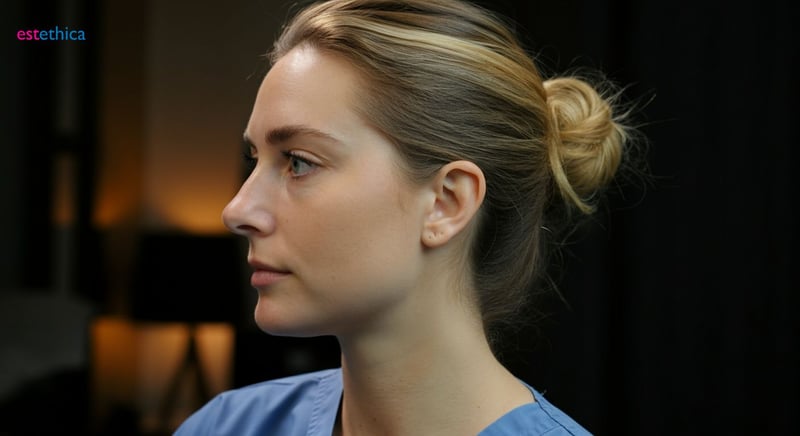Nose Reshaping: Your Journey to a Harmonious Profile
Nose reshaping with rhinoplasty offers a journey to enhanced confidence, aesthetic harmony, and improved breathing functionality, tailored to each individual’s needs.
Nose reshaping, often known as rhinoplasty, represents a significant possibility for those striving for facial harmony and improved self-esteem. Whether driven by aesthetic desires or medical need, rhinoplasty offers transformative benefits. It's more than a cosmetic procedure; it's a journey towards confidence and functionality. With an understanding of the options available and realistic expectations, this journey can lead to profound personal satisfaction.
Understanding Nose Reshaping: More Than Just Aesthetics
Exploring the Dual Benefits of Nose Reshaping
Nose reshaping, often termed rhinoplasty surgery, provides transformations that reach beyond aesthetics. While many consider it as a way to perfect their facial harmony, the procedure holds vital functional significance. This surgery isn't just about reshaping cartilage; it's about enhancing respiratory functionality, improving the quality of life for those affected.
The motivation to undergo 'nose reshaping' can stem from various factors, some prefer to reshape their noses for visual purposes while others require the surgery for functional reasons to restore health. Rhinoplasty may greatly improve people's lives by restoring equilibrium and improving both look and function.
Advantages of Choosing Nose Reshaping
- Corrects structural issues: Rhinoplasty can repair deviated septums, enhancing airflow and resolving chronic breathing problems.
- Provides both visual and functional improvements: Cosmetic nose reshaping will bring balance to facial aesthetics while addressing functional needs, improves overall health.
- Boosts quality of life: Better breathing leads to better sleep, increased physical activity tolerance, and enhances general well-being.
Understanding the Full Spectrum of Rhinoplasty Options
Functionally, 'nose reshaping' addresses conditions like a deviated septum, leading to chronic difficulty in breathing. A well done septoplasty not only enhances visual appearance but also the overall quality of life. A properly executed 'rhinoplasty' can dramatically alter one’s life by improving breathing and subsequently, improving sleep and overall health.
Key Steps to Prepare for Your Rhinoplasty Procedure
- Consult with a board-certified surgeon: Discuss your goals, medical history, and any concerns, as well as the cost rhinoplasty.
- Undergo a comprehensive examination: Assessment of nasal structure including breathing and overall health, to determine appropriate intervention.
- Follow pre-operative guidelines: Adjust medications, quit smoking, and prepare for recovery to ensure optimal results.

Rhinoplasty Surgery: Exploring Surgical Techniques and Innovations
Navigating Open vs. Closed Rhinoplasty Options
Rhinoplasty is a specialized procedure, tailored to various requirements through different techniques. 'Rhinoplasty surgery' can be performed using either open or closed techniques. Open rhinoplasty involves making a small incision on the columella, which allows the surgeon to have an extensive view of the nasal structures. This is particularly useful for complex reshaping. In contrast, closed rhinoplasty involves incisions made inside the nose, resulting in no external scars and often a faster recovery period.
The ideal technique for nose reshaping is based on individual anatomy, desired outcomes, and the surgeon's expertise. Some surgeons might favor one method over the other based on their training and experience. Each approach has its advantages, making the choice a collaborative decision between the patient and surgeon.
Exploring Innovations in Rhinoplasty Techniques
- Ultrasonic Rhinoplasty: Uses precise sound waves to reshape bone, minimizing damage to soft tissues and accelerating recovery.
- 3D Imaging: Allows surgeons to create a detailed surgical plan and provide a visual representation, enhancing patient satisfaction.
- Grafting Techniques: Involves using cartilage from different parts of the body to rebuild and refine the nose structure effectively.
Understanding the Role of Technology in Modern Rhinoplasty
Innovations such as ultrasonic rhinoplasty are revolutionizing how 'nose reshaping' is approached. This technique employs ultrasonic waves that allow for precise bone reshaping without causing significant trauma to the surrounding tissues. Patients benefit from reduced swelling, less bruising, and a quicker return to normal activities.
Surgeons use 3D imaging to simulate the potential outcomes of 'rhinoplasty surgery', allowing 'nose reshaping' expectations to be managed effectively. This technology enables precise surgical planning, enhancing both the aesthetic results and patient satisfaction. For instance, predictive imaging can show how changes to the nasal bridge impact overall facial harmony, ensuring that the outcomes align with the individual’s facial structure.
Considerations Influencing Rhinoplasty Technique Selection
- Complexity of Reshaping: Open rhinoplasty used for significant adjustments; closed approach for minor corrections.
- Patient Recovery Timeline: Closed rhinoplasty preferred for quicker recovery due to minimal external incisions.
- Surgeon’s Expertise: Surgeon's comfort and proficiency greatly influences choice of technique.

Beyond the Knife: Non-Surgical Nose Job Options for Subtle Changes
Exploring the Convenience of Liquid Nose Job
Non-surgical nose jobs offer a compelling alternative for those seeking subtle enhancements without undergoing invasive surgery. The liquid nose job, or non-surgical rhinoplasty, uses dermal fillers to temporarily correct minor imperfections, such as smoothing out small bumps or lifting the tip of the nose. This procedure is quick, often completed in less than an hour, and involves minimal to no downtime, making it an appealing option for individuals wary of traditional surgical methods. Many choose this route due to its reduced risk compared to surgical options, aiming for slight corrections that complement their overall facial features, rather than drastic changes.
Despite the advantages, it’s crucial to note that the effects of dermal fillers are not permanent, requiring periodic maintenance to sustain the desired appearance. However, it serves as an excellent initial step for those contemplating more permanent solutions or adjustments not necessitating surgical intervention. This aligns particularly well with individuals preferring temporary, low-impact aesthetic improvements.
Key Considerations Before Opting for a Liquid Nose Job
- Temporary Results: Understand that fillers provide temporary corrections, typically lasting from six months to two years.
- Correction Limitations: Liquid rhinoplasty best suits minor imperfections rather than significant reshaping.
- Maintenance Requirements: Regular follow-up appointments needed to maintain the altered new shape to preserve the desired appearance.
Understanding Liquid Rhinoplasty and Its Subtle Transformations
While the liquid nose job offers enhanced convenience and reduced risks, it is primarily useful for gentle alterations rather than significant structure changes. Individuals seek it as a non-committal way to explore how minor changes could enhance their facial aesthetics. The semantatic tag 'liquid nose job' is indeed a convenient solution for individuals seeking subtle changes without committing to surgery. This option is suitable for those aiming for minor alterations, like smoothing a dorsal hump or altering the nasal tip.
The process involves injecting fillers into specific areas of the nose to reshape its contours. According to recent surveys, about 65% of patients who underwent liquid rhinoplasty were highly satisfied. While it provides a quick aesthetic solution through 'nose reshaping', patients should consider that, unlike a surgical intervention, the effects are non-permanent.
Steps Involved in a Typical Liquid Nose Job Procedure
- Initial Consultation: Discuss aesthetic goals, and assess nasal anatomy to determine suitability.
- Filler Injection: Inject small amounts of dermal filler strategically placed.
- Post-Procedure Monitoring: Monitor for immediate reactions and provide aftercare instructions.

Rhinoplasty Before and After: Realistic Expectations and Transformations
Setting Achievable Expectations for Nose Reshaping
The journey of 'rhinoplasty surgery' is marked by the potential for substantial aesthetic changes. However, it is very important to have realistic expectations to ensure satisfaction. Detailed consultations before the surgery are important, where desired results are discussed thoroughly, balancing the patient’s vision with the achievable surgical outcomes. Reviewing before-and-after photos from estethica Global showcases the realistic changes that surgery can achieve, offering a transparent view of potential transformations.
Understanding recovery after the procedure is also very important. Swelling and bruising are normal but temporary conditions, with final results noticeable over several months. Good communication between patient and surgeon is key, aligning expectations with potential outcomes to ensure delight with the results. This collaborative approach is essential in realizing a successful transformation that meets the patient’s goals.
Critical Factors Influencing Rhinoplasty Expectations
- Detailed Pre-Surgical Dialogue: Open communication ensures the feasibility of patient desires, contributing to happy outcomes.
- Realistic Visual References: Before and after 'nose reshaping' galleries provide reliable insight into what 'rhinoplasty surgery' can achieve.
- Comprehensive Understanding of Recovery: Knowing the recovery process is vital in keeping expectations and ensuring satisfactory results.
Navigating The Rhinoplasty Recovery Timeline
Recovery involves careful management and patience; it's important to carefully follow your surgeon’s advice. You can support your healing by getting lots of rest, keeping the area elevated, and adhering to medication schedules to manage any discomfort. The initial period of swelling and bruising gradually resolves, revealing the refined contours of the nose.
It’s also important to acknowledge emotional aspects during the healing phase. Changes in appearance can influence one's self-perception, so a good and encouraging outlook can make the experience more pleasant. Regular follow-ups with 'estethica Global' ensure that the recovery is on track. These touchpoints provide opportunities to address issues, reinforcing patient confidence in the process and the final results.
Essential Steps for Optimizing Rhinoplasty Recovery
- Strict Adherence to Post-Op Instructions: Minimize swelling and bruising by closely following all recommendations
- Regular Follow-Up Appointments: Get continuous support and assessment to ensure appropriate healing progress and proper adjustments.
- Positive Mindset and Emotional Support: Staying optimistic is vital.
Understanding Rhinoplasty: A Comprehensive Guide
Ultrasonic Rhinoplasty for Precise Bone Reshaping with Accelerated Recovery
Comprehensive Pre- and Post-Operative Care Ensures Optimal Rhinoplasty Recovery and Satisfaction
Frequently Asked Questions
What is rhinoplasty and what are its primary benefits?
What are the different techniques available in Rhinoplasty surgery?
What is a non-surgical Nose job, and who is it suitable for?
How important is it to have realistic expectations for rhinoplasty before and after results?
What is the typical Rhinoplasty recovery timeline?
Achieve your aesthetic goals with estethica's expert guidance and personalized treatment plans.
📞 Book Your Free Consultation!